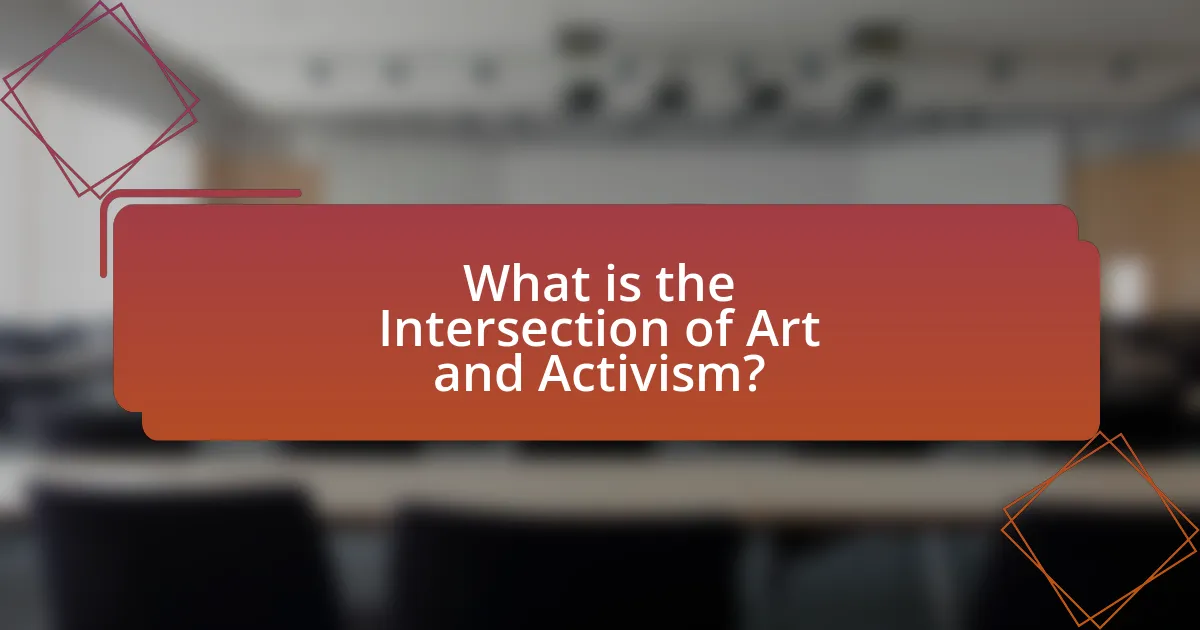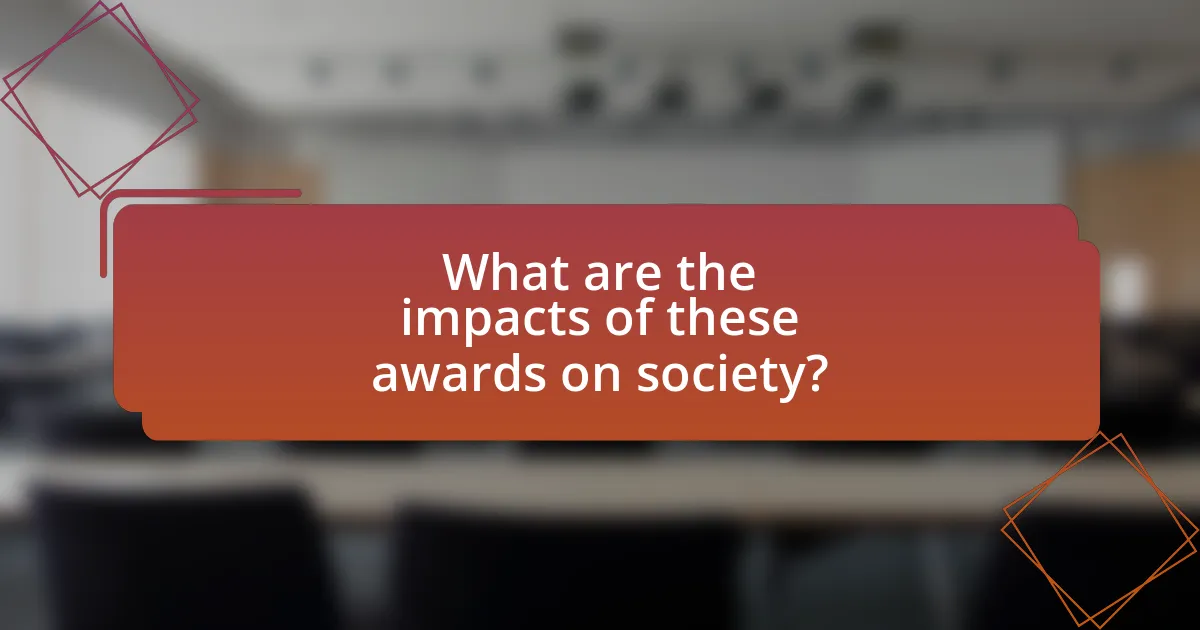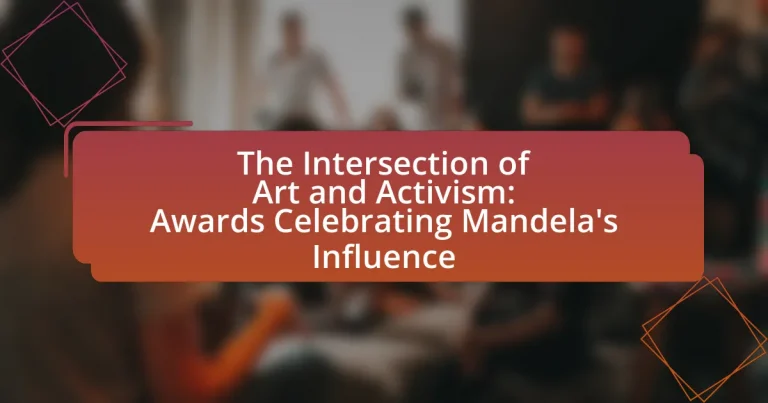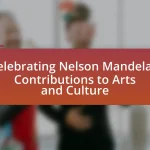The article explores the intersection of art and activism, highlighting how artistic expression serves as a powerful tool for promoting social change and raising awareness about political and social issues. It examines historical and contemporary examples of artists who have utilized their work to challenge injustices and inspire movements, such as Ai Weiwei and the Harlem Renaissance. Additionally, the article discusses various awards that celebrate Nelson Mandela’s influence, recognizing individuals and organizations that embody his values of social justice and human rights through art. The significance of these awards in promoting activism within the arts and their impact on society are also analyzed, along with ways individuals can support this intersection.

What is the Intersection of Art and Activism?
The intersection of art and activism refers to the use of artistic expression as a means to promote social change and raise awareness about political and social issues. Artists often leverage their creative platforms to challenge injustices, inspire movements, and engage communities in dialogue. Historical examples include the works of artists like Ai Weiwei, whose installations critique government oppression, and the Harlem Renaissance, which used literature and visual arts to address racial inequality. This intersection highlights how art can serve as a powerful tool for activism, influencing public perception and mobilizing action.
How do art and activism influence each other?
Art and activism influence each other by using creative expression to amplify social and political messages. Artists often draw inspiration from social injustices, creating works that provoke thought and inspire action, while activists utilize art as a tool to engage communities and raise awareness. For example, the works of artists like Ai Weiwei and Banksy have highlighted issues such as human rights and political corruption, effectively mobilizing public sentiment and action. This symbiotic relationship is evident in movements like the Civil Rights Movement, where music, visual art, and literature played crucial roles in conveying messages of equality and justice, demonstrating that art can serve as both a reflection of societal issues and a catalyst for change.
What are the historical examples of art serving as activism?
Art has historically served as activism through various movements and works that address social and political issues. For instance, the Harlem Renaissance in the 1920s utilized literature, music, and visual arts to challenge racial discrimination and celebrate African American culture. Similarly, Pablo Picasso’s “Guernica,” created in response to the bombing of the Spanish town during the Spanish Civil War, powerfully condemned war and violence. Additionally, the AIDS activism of the 1980s saw artists like Keith Haring use public art to raise awareness about the epidemic and advocate for marginalized communities. These examples illustrate how art has been a vital tool for social change and activism throughout history.
How does contemporary art reflect social movements?
Contemporary art reflects social movements by serving as a medium for expression, critique, and awareness of societal issues. Artists often engage with themes such as racial equality, gender rights, and environmental justice, using their work to challenge the status quo and provoke dialogue. For instance, the Black Lives Matter movement has inspired numerous artworks that address systemic racism and police brutality, exemplified by pieces like “Say Their Names” murals that memorialize victims of violence. Additionally, exhibitions such as “The Feminist Art Project” highlight women’s rights and gender equality, showcasing how art can mobilize communities and influence public opinion. These examples demonstrate that contemporary art not only mirrors social movements but actively participates in shaping their narratives and impact.
Why is the intersection of art and activism significant?
The intersection of art and activism is significant because it serves as a powerful medium for social change and awareness. Art has the ability to convey complex messages and emotions, making it an effective tool for activists to communicate their causes and inspire action. Historical examples include the use of visual art during the Civil Rights Movement, where artists like Jacob Lawrence depicted the struggles and aspirations of African Americans, thereby raising awareness and fostering empathy. Additionally, contemporary movements, such as the use of street art in protests, demonstrate how art can mobilize communities and challenge societal norms. This synergy between art and activism not only amplifies voices but also creates a lasting impact on public consciousness and policy.
What role does art play in raising awareness for social issues?
Art serves as a powerful medium for raising awareness about social issues by conveying complex messages and emotions that resonate with diverse audiences. Through visual arts, music, literature, and performance, artists can highlight injustices, provoke thought, and inspire action. For instance, the works of artists like Ai Weiwei and Banksy have drawn global attention to issues such as human rights violations and political corruption, effectively mobilizing public discourse and advocacy. Historical examples include the use of protest songs during the Civil Rights Movement, which galvanized support and solidarity among activists. Thus, art not only reflects societal challenges but also acts as a catalyst for change by engaging individuals and communities in critical conversations about pressing social matters.
How can art inspire change in communities?
Art can inspire change in communities by fostering dialogue, raising awareness, and mobilizing action around social issues. For instance, public murals and community art projects often address local challenges, encouraging residents to engage with and reflect on their environment. Research shows that art initiatives can lead to increased community cohesion and empowerment, as seen in the “Art for Social Change” project, which demonstrated a 30% increase in community participation in local governance after implementing art-based interventions. Such evidence highlights the transformative power of art in driving social progress and community development.
What are the Awards Celebrating Mandela’s Influence?
The awards celebrating Nelson Mandela’s influence include the Nelson Mandela International Day Awards, which recognize individuals and organizations making a significant impact in their communities, and the Mandela Washington Fellowship, aimed at empowering young African leaders. These awards honor Mandela’s legacy of social justice and human rights, promoting values he championed throughout his life. The Nelson Mandela International Day Awards were established in 2010 by the United Nations to commemorate Mandela’s birthday and encourage global citizens to engage in community service. The Mandela Washington Fellowship, initiated in 2014, supports young African leaders through academic coursework, leadership training, and networking opportunities, reflecting Mandela’s commitment to education and leadership development.
What types of awards recognize contributions at this intersection?
Awards that recognize contributions at the intersection of art and activism include the Mandela Effect Awards, which honor artists who promote social justice and human rights through their work. These awards specifically celebrate the legacy of Nelson Mandela by acknowledging creative expressions that inspire change and advocate for equality. For instance, the Mandela Effect Awards highlight projects that align with Mandela’s values, such as peace, reconciliation, and community empowerment, thereby reinforcing the impact of art in activism.
Which organizations are involved in these awards?
The organizations involved in these awards include the Nelson Mandela Foundation and various cultural institutions that promote social justice through art. The Nelson Mandela Foundation is dedicated to preserving Mandela’s legacy and fostering social change, while cultural institutions often collaborate to recognize artists who embody Mandela’s values of equality and human rights. These partnerships enhance the awards’ credibility and impact, aligning with Mandela’s vision of using art as a tool for activism.
What criteria are used to select award recipients?
Award recipients are selected based on their significant contributions to social justice, human rights, and artistic expression that align with Nelson Mandela’s legacy. The criteria often include demonstrated commitment to activism, impactful community engagement, and the ability to inspire change through art. For instance, recipients may be evaluated on their previous work in promoting equality, their influence in raising awareness about critical issues, and their dedication to fostering a more just society, reflecting Mandela’s values of resilience and empowerment.
How do these awards honor Mandela’s legacy?
These awards honor Mandela’s legacy by recognizing individuals and organizations that embody his values of social justice, equality, and human rights. They celebrate artistic expressions that promote activism and inspire change, reflecting Mandela’s commitment to using art as a tool for social transformation. For instance, the Mandela Prize is awarded to those who have made significant contributions to the promotion of peace and human rights, directly aligning with Mandela’s lifelong dedication to these causes.
What specific values of Mandela are celebrated through these awards?
The specific values of Nelson Mandela celebrated through these awards include resilience, social justice, equality, and human rights advocacy. These awards honor Mandela’s unwavering commitment to fighting apartheid and promoting peace, as evidenced by his leadership in the anti-apartheid movement and his role as South Africa’s first Black president, where he emphasized reconciliation and nation-building. The awards also reflect Mandela’s dedication to empowering marginalized communities and fostering global solidarity, which aligns with his legacy of inspiring activism and artistic expression for social change.
How do the awards promote activism in the arts?
The awards promote activism in the arts by recognizing and celebrating artists who address social issues and inspire change through their work. By providing a platform for these artists, the awards amplify their messages and encourage public engagement with critical topics such as human rights, equality, and justice. For instance, awards like the Mandela Prize highlight the contributions of artists who embody Mandela’s legacy of activism, thereby motivating others in the arts community to use their talents for advocacy. This recognition not only validates the artists’ efforts but also fosters a culture of activism within the arts, encouraging collaboration and dialogue around pressing societal challenges.

What are the impacts of these awards on society?
The impacts of these awards on society include the promotion of social justice, recognition of artistic contributions to activism, and the inspiration of future generations. These awards highlight the importance of art in advocating for change, as seen in the legacy of Nelson Mandela, whose influence is celebrated through various artistic expressions. For instance, the Mandela Effect, a phenomenon where collective memory influences societal narratives, demonstrates how awards can shape public perception and encourage dialogue around critical issues such as equality and human rights. Additionally, awards often provide platforms for marginalized voices, fostering inclusivity and awareness within communities.
How do the awards influence artists and activists?
Awards significantly influence artists and activists by providing recognition, validation, and increased visibility for their work. This recognition often leads to greater opportunities for funding, collaboration, and public engagement, which can amplify their messages and causes. For instance, the Nobel Peace Prize has historically elevated the profiles of activists like Malala Yousafzai, resulting in increased support for education initiatives worldwide. Additionally, awards can inspire other artists and activists to pursue their passions, creating a ripple effect that fosters a more vibrant and engaged community focused on social change.
What opportunities do award winners gain for their work?
Award winners gain increased visibility and recognition for their work, which can lead to new professional opportunities. This recognition often results in invitations to speak at conferences, participate in exhibitions, or collaborate with other artists and activists. For instance, winning prestigious awards can enhance an artist’s credibility, attracting funding and sponsorships that support future projects. Additionally, award winners may gain access to exclusive networks and platforms that amplify their message and impact, furthering their ability to influence social change.
How do these awards affect public perception of art and activism?
Awards that celebrate art and activism significantly enhance public perception by validating the importance of these fields in societal change. Such recognition elevates the visibility of artists and activists, fostering a greater appreciation for their contributions to social justice and cultural dialogue. For instance, awards like the Mandela Prize not only honor individual achievements but also highlight the broader impact of art in advocating for human rights, thereby inspiring public engagement and awareness. This effect is evidenced by increased media coverage and public discourse surrounding the awarded works, which often leads to heightened interest and support for related causes.
What can individuals do to support the intersection of art and activism?
Individuals can support the intersection of art and activism by actively participating in and promoting art initiatives that address social issues. Engaging in community art projects, attending exhibitions that focus on activism, and sharing art that raises awareness about social justice can amplify the message and impact of both art and activism. For instance, organizations like Art for Justice have successfully used art to advocate for criminal justice reform, demonstrating how creative expression can drive social change. By supporting such initiatives, individuals contribute to a broader movement that intertwines artistic expression with activism, fostering a culture of awareness and engagement.
How can one participate in or promote these awards?
To participate in or promote the awards celebrating Mandela’s influence, individuals can submit nominations for deserving candidates, volunteer for organizing committees, or engage in social media campaigns to raise awareness. Participation often involves following specific guidelines set by the award organizers, which may include deadlines for nominations and criteria for eligibility. Promoting these awards can be effectively achieved by sharing information through various platforms, collaborating with local organizations, and encouraging community involvement, thereby amplifying the message of Mandela’s legacy in art and activism.
What are effective ways to engage with art that advocates for social change?
Effective ways to engage with art that advocates for social change include participating in community art projects, attending exhibitions focused on social issues, and utilizing social media platforms to share and discuss impactful artworks. Community art projects, such as murals or installations, foster collaboration and dialogue among participants, enhancing awareness of social issues. Exhibitions that highlight social change themes, like those organized by institutions such as the Museum of Modern Art, provide critical context and provoke thought. Social media platforms, including Instagram and Twitter, allow for the rapid dissemination of art and ideas, enabling broader conversations around social justice. These methods have been shown to increase public engagement and awareness, as evidenced by initiatives like the “Art for Change” program, which successfully mobilized communities around social issues through artistic expression.




